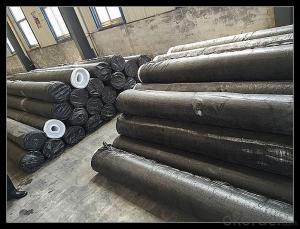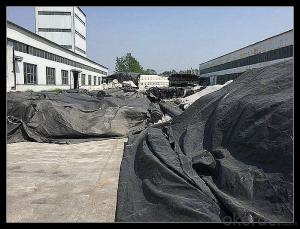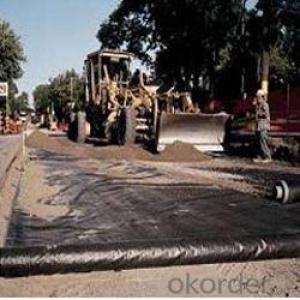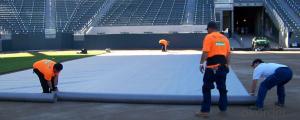Polypropylene PP Nonwoven Geotextile Fabric Materials
- Loading Port:
- China main port
- Payment Terms:
- TT OR LC
- Min Order Qty:
- 1000 g/m²
- Supply Capability:
- 1000000 g/m²/month
OKorder Service Pledge
OKorder Financial Service
You Might Also Like
Item specifice
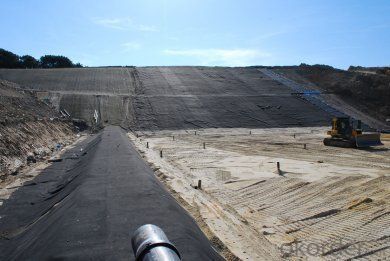
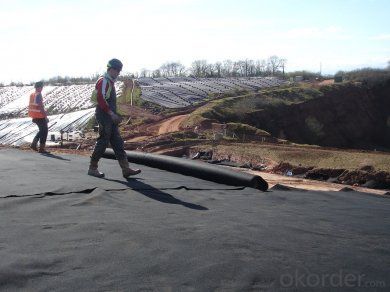
Non-woven geotextile fabrics are primarily used for projects where highly permeable separators are required. This includes applications that must allow water to flow while preventing soil erosion or soil loss.
Non-woven geotextiles are ideal for use in foundation drainage, behind retaining walls and gabions, in sub-drains, and under rip-rap & armourstone.
Most environmental codes and regulations will require geosynthetic linings for landfill and waste management projects.
Our non-woven geotextile fabrics contain high-grade polypropylene fibres to provide physical strength and excellent fluid management properties.
Features:
Hydraulic conductivity
Ultra violet rays protection
Low permeable
Tear resistance
Packaging & Shipping
Packing: PLASTIC FILM INSIDE, AND WOVEN BAG OUTSIDE
Shipping: About 15 days after receipt the deposit
Quality assurance
1.On a regular basis or as per your request,we entrust national testing agencies to conduct quality inspections
2. Strictly in accordance with the ISO9001-2008 international quality system standard,we monitor and manage the whole process throughout production,quality testing,and measurement to ensure product quality
3. For quality-related construction delay or substandard construction(except for damage or losses due to customer’s responsibility or irresistible natural disasters),we have refunding,replacement,and repair services.We will respond to customers’ feedbacks on quality issues within 24 hours.
After-sales service
1.In order to provide customers with comprehensive technical support,we will provide technical and other related information upon request in a timely manner.
2.In required,we will appoint specialized technicians to the construction site to give technical trainings to construction people,and offer technical guidance throughout the whole construction process.
3.For damage due to shipment and delivery,after we receive the complaint,we will check the issure through provided pictures and videos.If our responsibility is confirmed,we wil offer free replacement.
4.When the construction is completed,as your request,our technical staff may participate in the final acceptance.
FAQ:
Q: What kind of payments does jenor support?
A: T/T, L/C, Cash are accepted.
Q: Do you charge for the samples?
A: Accordeing to our company policy, the samples are free, we only charge the freight fee. And we will return the freight fee during the next order.
Q: Can you produce according to customers' design?
A: Sure, we are professional manufacturer, OEM and ODM are both welcome.
Q: Do you have other products?
A: Yes, please check the pictures:
- Q:What is the quota of pond compound geotextile cover?
- 500 grams of a cloth or a film or two cloth a film, water depth of 3-5 meters without any problems, and then into a deep reservoir, and then you can use 700 grams of the pond with the Yuanmingyuan do impermeable with 150 / 0.4 Mm, but the general pond 150 / 0.3mm is very good.
- Q:How do geotextiles contribute to groundwater recharge?
- Geotextiles contribute to groundwater recharge by providing a permeable barrier that allows water to infiltrate into the ground while retaining sediment and preventing erosion. This helps to replenish underground aquifers and maintain water levels, ultimately supporting the replenishment of groundwater resources.
- Q:How are geotextiles tested for filtration efficiency?
- Geotextiles are typically tested for filtration efficiency using standardized laboratory tests such as the ASTM D4491 test method. This method involves measuring the flow rate of water through the geotextile under specific pressure conditions and determining the percentage of particles retained by the fabric. Other tests may also be conducted to assess the geotextile's ability to retain soil particles and prevent clogging.
- Q:How do geotextiles prevent soil erosion?
- Geotextiles prevent soil erosion by acting as a barrier that stabilizes the soil, allowing water to pass through while preventing the movement of soil particles. They provide reinforcement to the soil, reducing the erosive forces of wind and water, and promoting vegetation growth by retaining moisture and nutrients in the soil.
- Q:Principle of drainage pipe geotextile
- Principle of drainage pipe geotextile
- Q:How do geotextiles interact with other geosynthetic materials?
- Geotextiles interact with other geosynthetic materials by complementing their functions and enhancing their performance. They can be used in conjunction with geogrids, geomembranes, and geocomposites to provide reinforcement, filtration, separation, and drainage capabilities. Geotextiles also help to prevent the intermixing of different soil layers and facilitate the flow of water, ensuring stability and long-term performance of geosynthetic systems.
- Q:Filament, preferably concrete construction
- Tianhai new material filament geotextile case analysis of water conservancy projects: seawall, river embankment, lake embankment project; reservoir reinforcement project; reclamation project; flood control and rescue. Highway and railway engineering: soft foundation reinforcement treatment; slope protection; road anti-reflective crack structure layer; drainage system; green isolation zone. Electrical engineering: nuclear power plant basic engineering; thermal ash dam project; hydropower project.
- Q:How do geotextiles contribute to the stability of railroad ballast?
- Geotextiles contribute to the stability of railroad ballast by acting as a barrier between the ballast and the underlying soil. They prevent the migration of fine particles from the soil into the ballast, reducing the risk of ballast contamination and subsequent track settlement. Geotextiles also provide reinforcement to the ballast, distributing loads more evenly and enhancing its overall stability.
- Q:Geotextile 500 grams is what it means
- 500 grams of geotextile is the weight of each square, geotextile have different specifications, generally ranging from 80g-800g, I was the manufacturer, welcome to visit
- Q:How do geotextiles help in preventing the loss of fine particles in filter layers?
- Geotextiles help prevent the loss of fine particles in filter layers by acting as a physical barrier that allows water to pass through while retaining the fine particles. This helps to maintain the integrity and effectiveness of the filter layer by preventing clogging and erosion caused by the movement of these particles.
1. Manufacturer Overview |
|
|---|---|
| Location | |
| Year Established | |
| Annual Output Value | |
| Main Markets | |
| Company Certifications | |
2. Manufacturer Certificates |
|
|---|---|
| a) Certification Name | |
| Range | |
| Reference | |
| Validity Period | |
3. Manufacturer Capability |
|
|---|---|
| a)Trade Capacity | |
| Nearest Port | |
| Export Percentage | |
| No.of Employees in Trade Department | |
| Language Spoken: | |
| b)Factory Information | |
| Factory Size: | |
| No. of Production Lines | |
| Contract Manufacturing | |
| Product Price Range | |
Send your message to us
Polypropylene PP Nonwoven Geotextile Fabric Materials
- Loading Port:
- China main port
- Payment Terms:
- TT OR LC
- Min Order Qty:
- 1000 g/m²
- Supply Capability:
- 1000000 g/m²/month
OKorder Service Pledge
OKorder Financial Service
Similar products
New products
Hot products
Hot Searches
Related keywords
